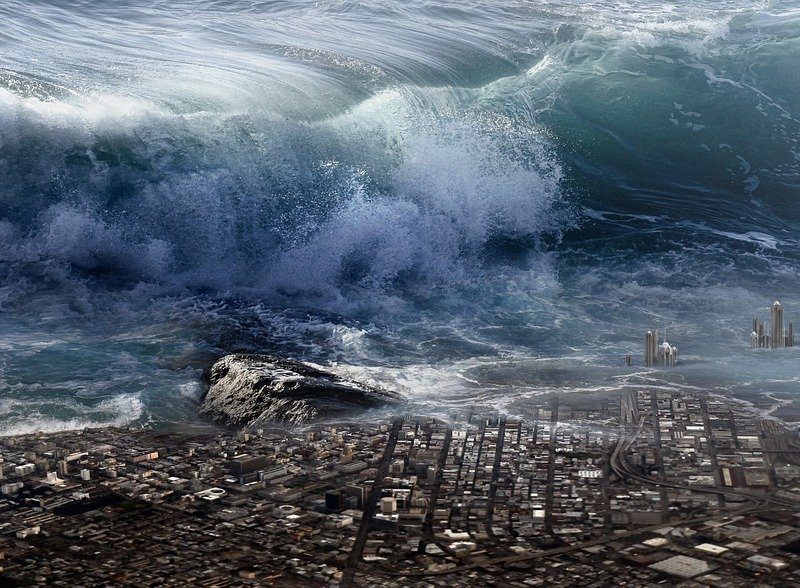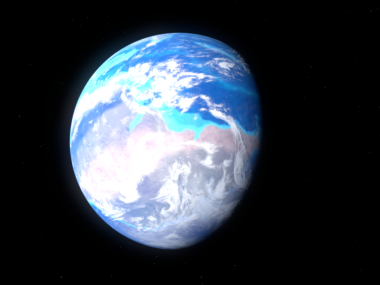The sedimentary layers that make up the vast majority of the Paleozoic, Mesozoic, and Cenozoic rock layers are incredibly important to understanding the processes of the Flood and its aftermath. Thousands of feet worth of fossil-bearing sediment are recorded in the geologic column. Any Flood models made must attempt to provide an adequate explanation for their origin. Additionally, the Great Unconformity that lies at the very bottom of all of those layers represents a huge erosional surface. What processes could cause such a dramatic, worldwide boundary? Dr. John Baumgardner, a geophysicist, has researched the possible role of large tsunamis in creating these vast sedimentary sequences.
The following is a summary of “Understanding How the Flood Sediment Record was Formed: The Role of Large Tsunamis” by John Baumgardner, and of the surrounding discussion and research pertaining to it. The views expressed do not necessarily reflect those of New Creation.
What a Flood Model Needs to Explain
This study revealed that the Flood model has to explain many questions regarding the geologic record, including:
- “What was the source of such a massive quantity of sediment during such a brief span of time?”
- “What sort of water process might conceivably emplace so much sediment above sea level on top of that land surface?”
- “What sort of transport and depositional process could conceivably generate such uniform layers over such vast horizontal distances?”
- “In the context of the Flood, what is the mechanism responsible for such repetitive and detailed structure? [bedding planes]”
- “In the context of the Flood, what mechanism might account for this pattern [of megasequences]?”
- “When in earth history did such intense erosion [of the continental shields] occur if it was not during the Genesis Flood? And by what sort of process?
The Effects of Tsunamis
Tsunamis are large waves of water that are typically generated by forces such as earthquakes or massive landslides. The release of energy propagates a wave and upon reaching the shore the wave increases in height as the seafloor gets more shallow.
Of course in Scripture it is clear that the Flood was an incredibly catastrophic event. It is therefore very likely that tsunamis would be quite frequent during this process. In Genesis 7:11 (ESV), we read that “all the fountains of the great deep burst forth.” This could hint at violent breakup of the seafloor.
Dr. Baumgardner considers the potential power and effect that tsunamis could cause in his Flood model. He notes that they could occur as frequently as 360 times per day, according to his calculations. Because of the great magnitude and the high occurrence of these tsunamis, the effects would be devastating. They would also explain how so much water could stay on the continents during the Flood—the constant bombardment of repetitive waves would help force the water onto the land. This would also be quite effective in large-scale erosion of bedrock. Additionally, the process would be capable of transporting and spreading incredible amounts of sediment across the continents.
Baumgardner’s research included calculations and computer modelling to simulate what the land would have looked like at the beginning of the Flood.
What we observe in the geologic record are rock layers that can extend across entire continents—or even across multiple continents! This phenomenon would be consistent within a biblical Flood framework, but what sort of processes during the cataclysmic event would be responsible for the widespread deposition?
Are Tsunamis the Answer?
The study found that a good estimate for the average thickness of sedimentary rock over the continents that the Flood laid down would be approximately 2000m. For each day of this intense period of the Flood where “the water prevailed on the earth,” the average depositional rate would be about 13.3m/day. Many other factors play into the modeling as well; speed and distance of sediment transportation, how much sediment was in the water by volume, etc.
The mechanism behind tsunami formation would have likely been attributed to rapid plate tectonic activity. (Baumgardner and others have suggested a model called Catastrophic Plate Tectonics, which could yield plate movement speeds at the scale of meters per second). Such “locking and episodic unlocking and slip of the overriding plate” (p. 290) would have produced many earthquakes. During the locking stage, the sea bottom would have been dragged down as the crust was being subducted. During the unlocking and slip stage, the sea floor rapidly bounces back and this would generate a massive tsunami. The tsunamis that resulted from this would have been beyond the order of anything we have seen in modern times. The Flood was truly a unique event in earth’s history.
Conclusion
Returning back to the list of questions posited earlier, this research gives some interesting insights. Initial tsunami action would have caused intense, global erosion. This would contribute to the vast amount of sediment required for the Flood deposits. Those same processes would also be responsible for transporting those sediments far onto the surface of the continents and could explain the extensive uniform layers over great geographical distances. Additionally, the ebb and flow of these waves could help to explain the distinct bedding planes we observe in the geologic record.
In the future, as this numerical modelling improves, we may start to see more adequate explanations for megasequence structure. Better representations of the topography of the pre-Flood world in the model would undoubtedly yield important insights into all of these factors that were at play during that catastrophic year.












Tsunamis would also help to explain events like the accumulation of 10000 dinosaurs in one meter of mud over eighty acres or so in Wyoming. A high volume of high velocity water would explain the dismemberment and sorting and rapid burial of this high volume of dinosaur bone. Rapid burial was necessary so that the bone would not decay but would be preserved. Link: https://isgenesishistory.com/10000-dinosaurs/
You raise very good points! You may also want to check out our article on the Hanson Ranch Bonebed that incorporates the latest research on the fossil site:
https://newcreation.blog/the-bonebed-mystery-at-hanson-ranch/